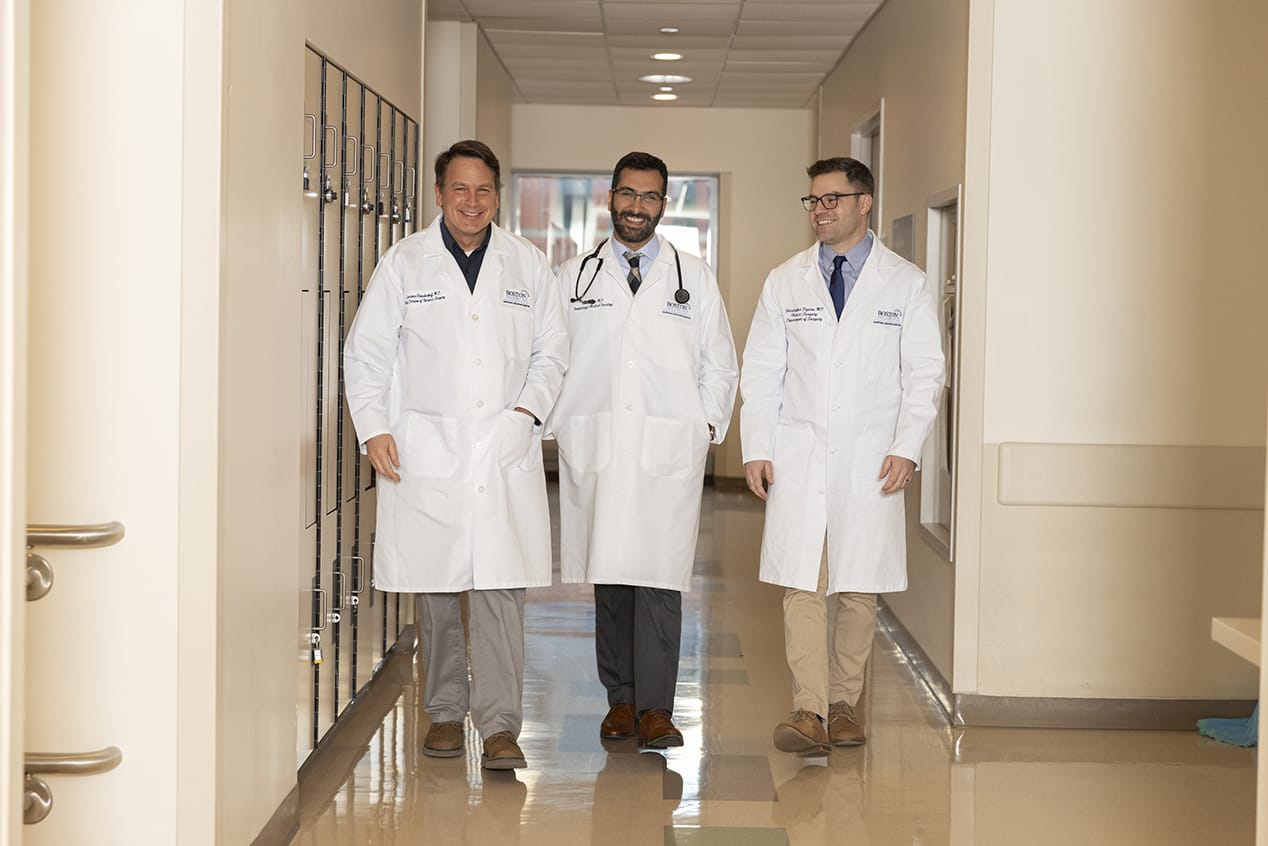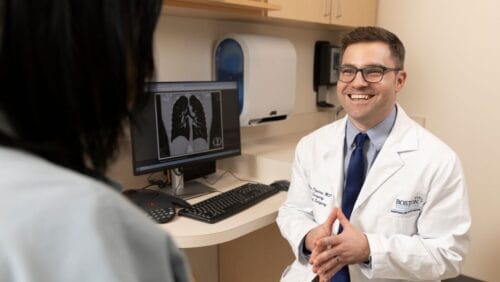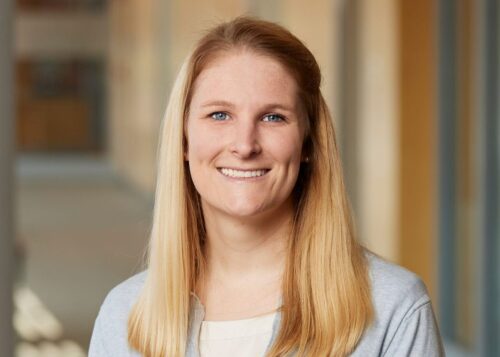Bringing Cutting-Edge Techniques and Patient-Centered Care to Boston Medical Center’s Thoracic Team
May 24, 2024
By Katie Dillon

Boston Medical Center
Laurence Brinckerhoff, MD, Umit Tapan, MD, and Christopher Digesu are leading BMC's robust thoracic surgery and lung cancer treatment plans.
BMC's new chief of Thoracic Surgery arrived with a clear-eyed optimism and a desire to build a well-rounded, elite team that delivers care with compassion.
Laurence Brinckerhoff, MD, believed he could make a difference when he arrived as the chief of Boston Medical Center’s thoracic surgery division in 2022. Though the thoracic surgery department already had a solid structure, Brinckerhoff knew they could do more. “I think our patients deserve the best,” he says now, with his self-described “Vermonter’s optimism.” “I saw so much opportunity at Boston Medical Center and just wanted to be able to provide the best product possible for patients who need it the most.”
That product, thoracic surgery — which treats diseases of the lungs, chest, and esophagus — fills a huge need in the U.S., where lung cancer tops the list of deadliest cancers, and, according to Brinckerhoff, at Boston Medical Center (BMC), lung cancer is the one of the most common reasons for thoracic surgery.
Thoracic surgery is just one element of a lung cancer treatment plan. If cancer is caught early enough, in stage 1, often patients will only need surgery to treat their cancer. Other times, in addition to surgery, chemotherapy or immunotherapy become necessary to help isolate and eradicate the cancer cells.
Early diagnosis is key in improving outcomes for patients. Though recent changes in strict national screening guidelines for lung cancer have led to an increase in early lung cancer detection and diagnoses, getting people screened and diagnosed early is still difficult. The national screening average is 5.8%, and while Massachusetts is well ahead of the curve at 16.8%, there is still a lot of progress needed in screening eligible patients. This is especially true at essential hospitals such as BMC, where large parts of the patient population are from historically marginalized groups with compounding social needs, like food or housing insecurity.
In addition to early detection and diagnoses, other ways to improve patient outcomes in lung cancer include access to the highest quality surgical and non-surgical treatment options.
The goal, then, for the incoming Brinckerhoff was to build the best thoracic team possible, to tap into the talent already present and recruit new talent where necessary.
A system built to ensure success in lung cancer treatment
Luckily, when Brinckerhoff arrived, BMC already had the critical components of a robust and committed non-surgical thoracic team. The lung nodule team — headed by pulmonologist Katrina Steiling, MD, was already doing immense work to eliminate gaps in lung cancer screening. Lung nodules, typically benign in people without risk of lung cancer, can be the first indication that cancer is present in at-risk individuals. Steiling and the lung nodule team were working with at-risk, eligible patients who came into the lung nodule clinic and ensuring that they get screened for lung cancer.

Laurence Brinckerhoff, MD and Christopher Digesu, MD are revitalizing BMC’s thoracic surgery program with clinical innovation and a patient-centered approach. (Boston Medical Center)
Umit Tapan, MD, a thoracic oncologist and another critical member of the BMC thoracic explains the crucial work that team was already doing: “Steiling’s work in the lung nodule clinic have put our rates of lung cancer screening for eligible patients higher than the national average.”
Tapan’s work in non-surgical treatment for lung cancer also caught Brinckerhoff’s eye. If a patient needs more treatment than just surgery, Tapan provides immunotherapy, chemotherapy, targeted treatment, and personalized medicine, which targets a person’s genes and molecular makeup to formulize a treatment.
Brinckerhoff also noted the collaboration among the Pulmonology, Oncology, and Radiology departments and the way providers of different specialties — from doctors to nurses to social workers to radiology technicians — all worked together.
“This is a really awesome team,” says Brinckerhoff, “We’re collaborative and supportive. Whenever a tough case comes up — and they do — we all work together.”
Brickerhoff shares the story of a patient with advanced disease who underwent chemotherapy and immunotherapy before any surgery. The patient did well with the pre-surgical treatments and then had a successful surgery and successfully started an immunotherapy treatment after his surgery.
“And it was all coordinated on our end, going from the lung nodule group to Surgery to oncologists back to Surgery and then back to Oncology,” says Brinckerhoff, “We’re a whole team working together, and that’s what our patients deserve.”
All that was missing at the time of his hire, Brinckerhoff thought, were other thoracic surgeons in addition to himself.
Bringing high-end thoracic surgery to Boston Medical Center
Soon after he joined BMC, Brinckerhoff brought on Christopher Digesu, MD, to the team, a thoracic surgeon who specializes in robotics and minimally invasive surgical procedures.

Christopher Digesu, MD, one of BMC’s newest thoracic surgeons brings a wealth of robotic surgery knowledge. (Boston Medical Center)
“In addition to the patient population, Dr. Brinckerhoff is one of the top reasons I came to work at BMC,” says Digesu. “He’s excellent, both technically and personally. He really knows what he’s doing from a surgical perspective, and everyone just loves him, from patients to fellow staff members.”
In their short time at BMC, Brinckerhoff and Digesu have also begun to revolutionize the surgical process for BMC patients by providing access to modern, high-end, minimally invasive thoracic surgical procedures.
Digesu says that a decade ago, most lung cancer surgeries were open-chest operations that required up to 10 days of post-operative recovery in the hospital. The field eventually evolved to video technology, which was at the bedside with minimal incision, but it was very technically limiting, according to Digesu. The new robotic technology at BMC allows for more flexible, wristed movements, which means the surgeon has a more precise window into the body cavity.
Both Digesu and Brinckerhoff note that doing surgeries through smaller incisions reduces the length of stay in post-operative care and allows patients to go back to their lives.
“We’re an essential hospital, and many of our patients have complex needs that haven’t been met, so we are always adjusting, always innovating to see how we can design our surgeries around each patient and give them what they need,” says Digesu, “We’re offering some of the most advanced minimally invasive techniques both from surgical and pre-surgical diagnostic standpoints. [And] I think we’ve built a team that gets people through the system who may fall through the cracks in other systems.”
An optimistic outlook toward the future of BMC’s thoracic department
Nearly two years into his tenure as chief of thoracic surgery at BMC, Brinckerhoff is still bringing that “Vermonter’s optimism” and a surgeon’s shrewdness to his thoughts about the present and future of thoracic surgery at BMC.
“I just would love to have people know that the quality of care here is really second to none,” he says, “We have great outcomes, we are doing cutting-edge surgery, we’re doing cutting-edge staging, we’re doing cutting-edge oncology,” he says. “The radiation therapy is as good or better than any place in the world. There’s nothing that we don’t do, and there’s nothing we don’t do well here.”


